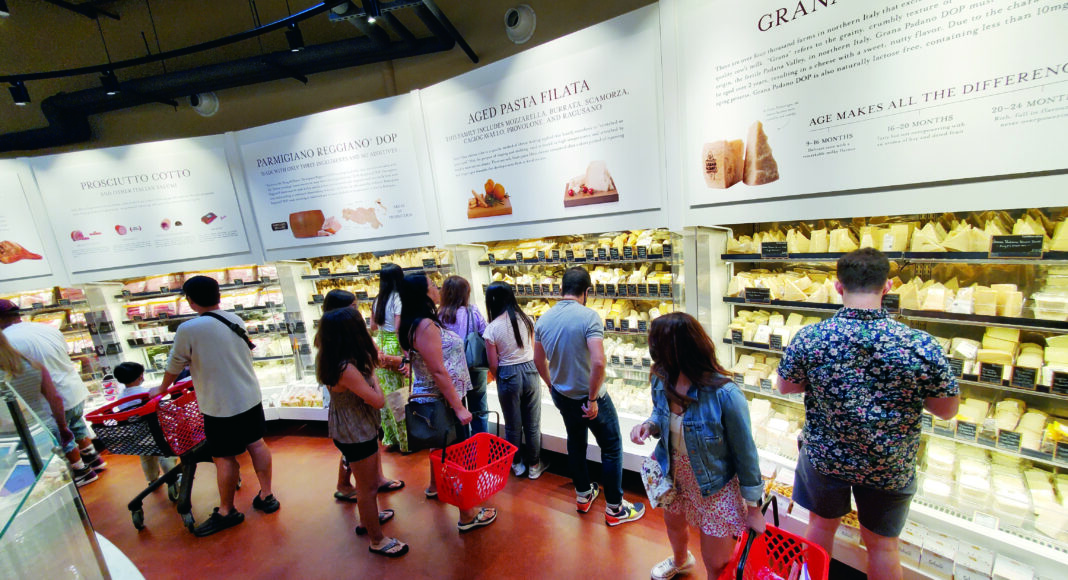If one needs to channel Marcello Mastroianni from the film La Dolce Vita, and his aimless wanderings through the horrors of uninhibited excess, no better place exists than Eataly in Valley Fair.
Federico Fellini’s three-hour visual masterpiece starred Marcello as a directionless, emotionally detached newspaper columnist, adrift from event to event, in search of story ideas amid the highbrow glitz and glamor. The film gave the English language the concept of paparazzi, so as a member of the local press, even without Marcello’s dark shades and perpetual cigarette, I had to infiltrate Eataly, the brand-new three-story emporium of Italian mass consumption. Fellini would have ridiculed the whole place up, down and sideways, so I had to go.
On my first visit, a few days after the grand opening, I couldn’t even get in. The line snaked its way out the door into the 95-degree sun, where about 40 suburbanites waited, licking their chops to finally get a looksee. The second time around, I actually made it inside. Since La Dolce Vita featured numerous staircase themes, with Marcello always descending or ascending to the next level of purgatory, this is exactly what it felt like going up and down three levels of escalators.
As soon as I arrived at the top floor, there was a fight near the cherry marmalade. A customer claimed an employee made derogatory remarks to him. I did not see the beginning of the altercation, only the end, when the customer shoved the employee into the Lavazza coffee shelves.
Marcello was a passive kind of actor, so I stood with the other patrons and watched the melee unfold. Eataly was lucky no real paparazzi were present. Thankfully, a few managers emerged from the back rooms to de-escalate the conflict, after which I wandered over to the $18 bags of Piemontese hazelnuts.
As a columnist, Marcello is both the observer and a character in La Dolce Vita. Everything emerges from his own cosmology. The audience only receives a superficial, surface-level understanding of the characters’ lives. This is how it felt, as I drifted from floor to floor. I don’t know why the fight happened, just as I don’t know anything about the heavyset European couple that beat me to the front of the pizza line during my next visit. They must have dropped $150 right in front of me.
As I then scoped out a $9 slice of Tricolore—prosciutto, arugula and stracciatella—the line was already stretching out the door into the hot sun. When I arrived at the cashier moments later, two squat elderly ladies approached from the opposite direction and tried to cut to the front of the line. They were unsuccessful and not very happy about it.
Since this isn’t a film, I’ll spoil it for you. During my various drifts through mobs of people at Eataly, there was no scene with Anita Ekberg in the Trevi Fountain. A few women came close, but like Marcello in the film, I couldn’t get my shit together.
However, I will say this: The $40/lb langoustines and $48.90/lb scallops reminded me of the final scene in La Dolce Vita when the dead sea monster washes up on the beach. “You’ll make a fortune with this fish,” said one of the fishermen, in that scene. “It’s worth millions!”
The film then ended with Marcello abandoning his creative potential to remain with the insane people on the beach, so I decided not to do that. I instead escaped Eataly and rambled straight over to Tony & Alba’s. You see, nothing inside Eataly really makes me feel like Italy. Tony & Alba’s does: Dean Martin records tacked to the wall. People drinking Peroni outside on red and white tablecloths. Old newspaper stories, trinkets, tattered books and photos of DiMaggio in his prime. It’s all there. I was instantly back on the Adriatic, in Rimini, Trieste or the deserted outskirts of Bari, all of which I’ve actually visited. Besides, when I think of mom ’n’ pop restaurants, what comes to mind immediately? Italians. Of course. To get there, I jaywalked across Winchester, dodging speedy cars—just like Italy—and sat down, by myself, for a much better experience.
Marcello would have been proud.



